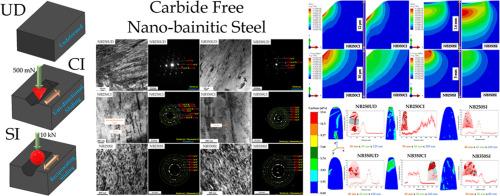滑动磨损下无碳化物纳米贝氏体钢应变驱动相变与碳偏析
IF 2.9
Q2 MATERIALS SCIENCE, MULTIDISCIPLINARY
引用次数: 0
摘要
将高碳钢在250℃和350℃分别进行奥氏体化和等温回火,制备出无碳化物的纳米贝氏体钢。采用锥形压头(CI)进行了单向滑动,采用球面压头(SI)进行了往复滑动。利用透射电子显微镜(TEM)和原子探针断层扫描(APT)比较了这两个过程的地下变形,并利用有限元计算计算了等效塑性应变和剪切应力。在碳偏析和微观结构演变方面存在明显差异,表明滑动摩擦的性质起着关键作用。在350℃的等温试样中,残余奥氏体完全转变为大部分孪晶马氏体,而在250℃的等温试样中,残余奥氏体部分转变为马氏体。而两种SI样品均表现出形变区碳分布均匀,残余奥氏体完全转变为马氏体。本文章由计算机程序翻译,如有差异,请以英文原文为准。

Strain-driven phase transformation and carbon segregation in carbide free nano-bainitic steel under sliding wear
Carbide free nano-bainitic steel was made by austenitizing and subsequent austempering a high carbon steel at 250°C and 350°C. Uni-directional sliding using conical indenter (CI) as well as reciprocating sliding using spherical indenter (SI) was carried out. The subsurface deformation was compared between these processes using transmission electron microscopy (TEM) and atom probe tomography (APT) while finite element computations were used to find the equivalent plastic strain and shear stress. There were distinct differences in carbon segregation and microstructural evolution signifying the critical role of the nature of sliding friction. The CI samples showed carbon segregation just below the indenter within the deformed zone and complete transformation of retained austenite to mostly twinned martensite for 350°C austempered sample and partial transformation for 250°C austempered sample. Whereas both SI samples show uniform distribution of carbon within the deformed zone as well as complete transformation of retained austenite to martensite.
求助全文
通过发布文献求助,成功后即可免费获取论文全文。
去求助
来源期刊

Materialia
MATERIALS SCIENCE, MULTIDISCIPLINARY-
CiteScore
6.40
自引率
2.90%
发文量
345
审稿时长
36 days
期刊介绍:
Materialia is a multidisciplinary journal of materials science and engineering that publishes original peer-reviewed research articles. Articles in Materialia advance the understanding of the relationship between processing, structure, property, and function of materials.
Materialia publishes full-length research articles, review articles, and letters (short communications). In addition to receiving direct submissions, Materialia also accepts transfers from Acta Materialia, Inc. partner journals. Materialia offers authors the choice to publish on an open access model (with author fee), or on a subscription model (with no author fee).
 求助内容:
求助内容: 应助结果提醒方式:
应助结果提醒方式:


